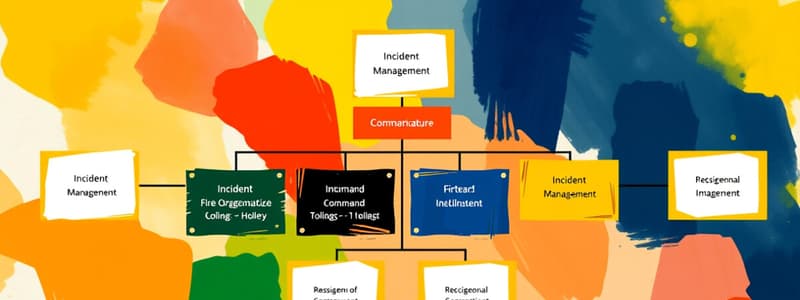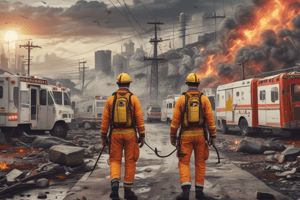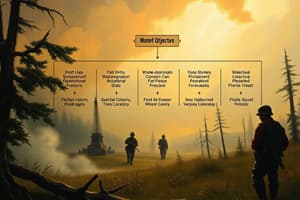Podcast
Questions and Answers
What information should Command communicate to Sector Officers about their new supervisor?
What information should Command communicate to Sector Officers about their new supervisor?
- The company personnel working in the sector
- The assigned tactical channel
- The frequency of the previous supervisor
- The Branch assignment and new radio channel (correct)
Which channel is designated for communications between the IC and Fire Branch?
Which channel is designated for communications between the IC and Fire Branch?
- Channel A
- Sector communication channel
- Tactical radio channel (correct)
- Branch Channel
What role do Branch Officers primarily hold during operations?
What role do Branch Officers primarily hold during operations?
- They are limited to supporting Sector operations.
- They operate in forward positions and manage communication. (correct)
- They serve as tactical coordinators exclusively.
- They monitor only Ground Control activities.
What must Sector Officers obtain before relaying radio information to Companies in their Sector?
What must Sector Officers obtain before relaying radio information to Companies in their Sector?
Which vehicle type should Branch Officers utilize as a forward Branch Command Post when applicable?
Which vehicle type should Branch Officers utilize as a forward Branch Command Post when applicable?
What is the primary purpose of adding Branches to the incident organization?
What is the primary purpose of adding Branches to the incident organization?
Who ultimately decides whether to expand the organization to include branches?
Who ultimately decides whether to expand the organization to include branches?
Under what circumstances should Branch Officers be utilized?
Under what circumstances should Branch Officers be utilized?
What radio channel do Branch Officers operate on when communicating with Command?
What radio channel do Branch Officers operate on when communicating with Command?
Which incident type is NOT an example where Branch Officers should be utilized?
Which incident type is NOT an example where Branch Officers should be utilized?
What is typically NOT a function of Branch Officers?
What is typically NOT a function of Branch Officers?
What aspect primarily defines the need for Branch Officers in very large-scale incidents?
What aspect primarily defines the need for Branch Officers in very large-scale incidents?
What type of incidents typically complicate the span of control, necessitating the use of Branch Officers?
What type of incidents typically complicate the span of control, necessitating the use of Branch Officers?
Flashcards are hidden until you start studying
Study Notes
Command Structure Overview
- The Branch level enhances COORDINATION between Sectors and Command.
- Adding Branches alleviates communication load on the Incident Commander (IC).
- Branch Officers supervise Sector Officers and report directly to the IC.
Command Organization Levels
- Strategic Level: Incident Commander (IC)
- Coordination Level: Branch Officers
- Tactical Level: Sector Officers
- Task Level: Companies
Situations for Branch Officer Deployment
- Utilize Branch Officers when the span of control with Sectors is maximized.
- Also needed in incidents with multiple major management components, such as:
- Large fires with evacuations.
- Large incidents with numerous casualties and significant hazards.
Examples of Incidents Requiring Branch Officers
- Hazmat incidents necessitating major evacuations.
- Large-scale incidents over broad geographic regions.
- Mass casualty incidents with additional hazards (fires, toxic spills, floods).
- Campaign high-rise fires.
- Incidents where Sectors exceed manageable spans of control.
Branch Officer Responsibilities and Communication
- Branch Officers manage Sector Officers and ensure effective operational direction.
- Communications with Command occur on the Tactical Channel.
- Radio designations reflect function or area (e.g., Fire Control Branch, West Branch).
- Separate radio channels are assigned for communications within Branches.
Notifications and Communication Procedures
- Sector Officers must be informed of their new supervision structure, including:
- Assigned Branch.
- Operating radio channel for the Branch and Sector.
- Sector Officers relay Branch communications and radio information to Companies in their Sectors.
- PAR (Personnel Accountability Report) must be obtained from Companies when switching radio channels.
Communication Protocols
- Communications between IC and Fire Branch use Tactical radio designations:
- “Command to Fire Branch” and “Fire Branch to Command.”
- Interactions between Fire Branch and West Sector occur on Channel A:
- “Command to West Sector” and “West Sector to Command.”
Branch Officer Assignment and Operations
- Chief Officers are typically assigned as Branch Officers.
- Branch Officers operate in forward positions, often utilizing a Command Officer's vehicle as a Branch Command Post.
- Command staff must monitor Branch radio channels from the Command Post.
- Any Section Officer may implement Branches as necessary within their section's context.
Studying That Suits You
Use AI to generate personalized quizzes and flashcards to suit your learning preferences.



